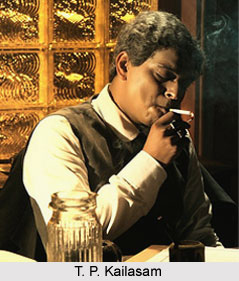 Thyagaraja Paramasiva Kailasam is a popular figure in the Kannada theatre scene. He was born in the year 1884, and was a playwright of eminence. He contributed greatly towards Kannada literature. He was so popular in the Kannada theatre that he earned the title Prahasana Prapitamaha, "the father of humorous plays".
Thyagaraja Paramasiva Kailasam is a popular figure in the Kannada theatre scene. He was born in the year 1884, and was a playwright of eminence. He contributed greatly towards Kannada literature. He was so popular in the Kannada theatre that he earned the title Prahasana Prapitamaha, "the father of humorous plays".
Early Life of T. P. Kailasam
Kailasam was born in Tamil family in southern Karnataka, in the year 1884. He received his higher educated in England. T. Parameswara Iyer, his father, was employed with the Mysore state service and was the younger brother of Madras High Court judge, Sir T. Sadasiva Iyer. T. P. Kailasam came from a family of scholars and professional people. While he was in England for higher education, he spent several time in theatres and attending classes and participating in many plays.
After his return from London, he took up a job at government geology service. He did his job seriously and prospered well. But soon, he lost interest and shed his former lifestyle and began living as a nocturnal bohemian, writing plays.
Life in Theatre for T. P. Kailasam
Kailasam came on the Kannada literary and dramatic stage in 1919. And was criticised to begin with, for modern use of the Kannada language in his plays, but, with time, his work gained popularity. His play, Namkampni, a satire which poured ridicule on the excesses of the professional theatre, was symbolic of his whole work in a way. The old professional stage never really recovered from the blow he dealt to it. Before his advent, the normal language of the drama was stilted and pedantic, the colloquial being almost exclusively reserved for `Vulgar` situations and characters. Kailasam felt that the professional stage debased pouranic themes; its actors were affected, stilted and hysterical. Kailasam jeered at the professional plays and at the audiences who crowded to see them. Like a true revolutionary, he desired a change from all that was deep rooted and monotonous.
Revolution Brought to Theatre by T. P. Kailasam
The old theatre, with its "meaningless" mythological plays, its tinsel spectacles and ` transfer scenes`, its strutting, ranting and moaning heroes, repelled him. He dismissed it with a supreme gesture and created a new, simpler and more dynamic stage with his own hands. The "great" hero of old was replaced by an ordinary lower middle-class individual, often a victim of social tyranny or domestic conflict. Kailasam saw drama in every home, an actor in every individual; he saw dramatic possibilities in each aspect of middle-class life and used these possibilities to portray and criticise the society he knew well. He made his characters speak as they might have spoken in real life. This met with the opposition of some who considered the stage too sacred for domestic themes and colloquial speech, but soon the audience realised that Kailasam had come to stay for their own benefit and delight, and that no opposition to him was possible. With perhaps the exceptions of Sattavana Santapa, Bahiskara and Soole, all the other plays of Kailasam (more than about twenty of them) have been repeatedly staged by amateur troupes all over the state of Karnataka. Among these troupes, the Amateur Drama Association, the Chaya Artists of Bengaluru and the Old Boy`s Association of the Maharaja`s College, Mysore, deserve special mention.
Successful Plays Written by T. P. Kailasam
Plays written by T. P. Kailasam came to be widely read for the humour if not for the significance of their social criticism. More than in the construction of plot, the genius of Kailasam is seen in the brilliant wit and humour that shine through his dialogues; but there is an over-flowing under-current of serious thought that adds to the significance of the play. These characteristics, typical of Kailasam, could be seen in plays like Ammavra Ganda, that provided parallel pictures of two house-holds, Talikattokkidine, that provided parallel pictures again, of the ways of a god-fearing traditionalist family with the ways of a dishonest sophisticated family; Bandvalvillada Badayi and Home Rule scathingly parodying artificial town-life: Nam Clubbu, poking fun at high-brow fashions: Nam Brahmanike, exposing the hollowness of the claims of our priesthood and Huttadalli Hutta, picturing the urban phenomenon of the exploitation of the dull by the clever. All the plays of Kailasam exhibit his remarkable ability in portraying the secret twists and turns of the social mechanism and in magnifying them from the angle of humour.
Kailasam turned his hand to mythological themes also, but treated these themes in English. Kama recreated the greatest of the tragic heroes of the Mahabharata, while the Purpose retold the story of Ekalavya who was `a victim of the Brahmin`s curse`.
Kailasam was a moralist, but he had the subtlety needed to carry off his moralising. His appreciation of what was really noble in traditional ways of living, added a grace to his plays. He gave the spoken language the status of literature. He created the new vogue for the satirical social play which proved that powerful prose with penetrating humour could do away with tinsel attractions of music, setting and costume.
T. P. Kailasam died in the city of Bengaluru in the state of Karnataka in the year 1946.




